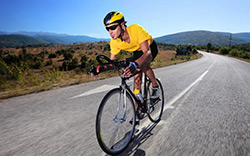FACT: Improving your Core Stability will improve your Cycling.
FACT: Most professional cyclists do core stability training weekly.
Having stiff segments to transfer force, is a given in engineering. You don’t hit a tennis ball with a cotton racquet: the ball wouldn’t go anywhere. Our bodies are no different. If the middle segment of the body, “the core”, is soft, weak, and floppy, there is no way that forces can be transferred efficiently between the upper and lower body. Thus movements like running, cycling, and jumping become much less efficient, and force is wasted. Having a strong core is therefore essential, and why trainers make such a big deal of it.
What does training for core strength involve? Core refers to the abdominal, lower back and gluteus muscles. Therefore core training refers to strengthening these muscles. A variety of movements including ones which isolate the core musculature, like crunches, as well as those which require force to be transferred through the core, like medicine ball throws. This is essential in many sports such as: rugby when passing or tackling; swimming to stop the body sagging in the middle; and gymnastics to help the arms and legs move in space. Lacking core strength will often limit the ability of the rest of the muscles to work to their potential.
Another key component of training the core is “core stability.” This is often described as the ability to react to changes in environment and maintain balance. For example when standing on a boat in rough seas and the surface you are standing on is constantly moving and changing. This sort of situation is typical in contact sports, in which opponents’ actions are uncontrollable and unpredictable. This stability has a large neural component. Much of this is derived from the central nervous system being able to react to what has happened, and fire the right muscles at the right time. Thus much of this involves practice.
Training “core stability” involves training on an unstable surface. Swiss balls, Bosu balls, Dura disks and wobble boards are just a few of the tools used to create an unstable surface. When on this unstable surface, typically, exercises are progressed by making the surface less stable. This sort of training, which can become as extreme as performing jump squats from Swiss ball to Swiss ball, has become very popular. Often times the question of specificity begs though. How will standing on a Swiss ball improve somebody’s ability to play hockey?
How can this improve your cycling?
Three specific ways that improved core stability will help improve your cycling:
- Less lateral hip rock during pedaling. (Therefore more efficient pedaling. When you watch the great cyclists ride, their hips remain still)
- Better posture on the bike (therefore more efficient pedaling and more aerodynamic positioning)
- Better force transfer from your whole body to the pedals.

